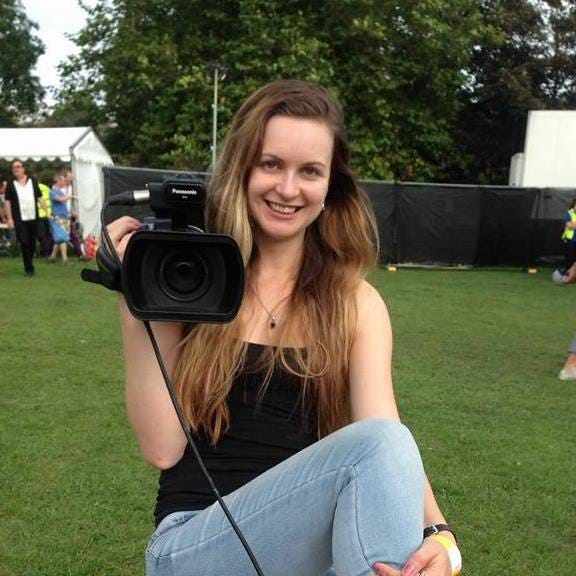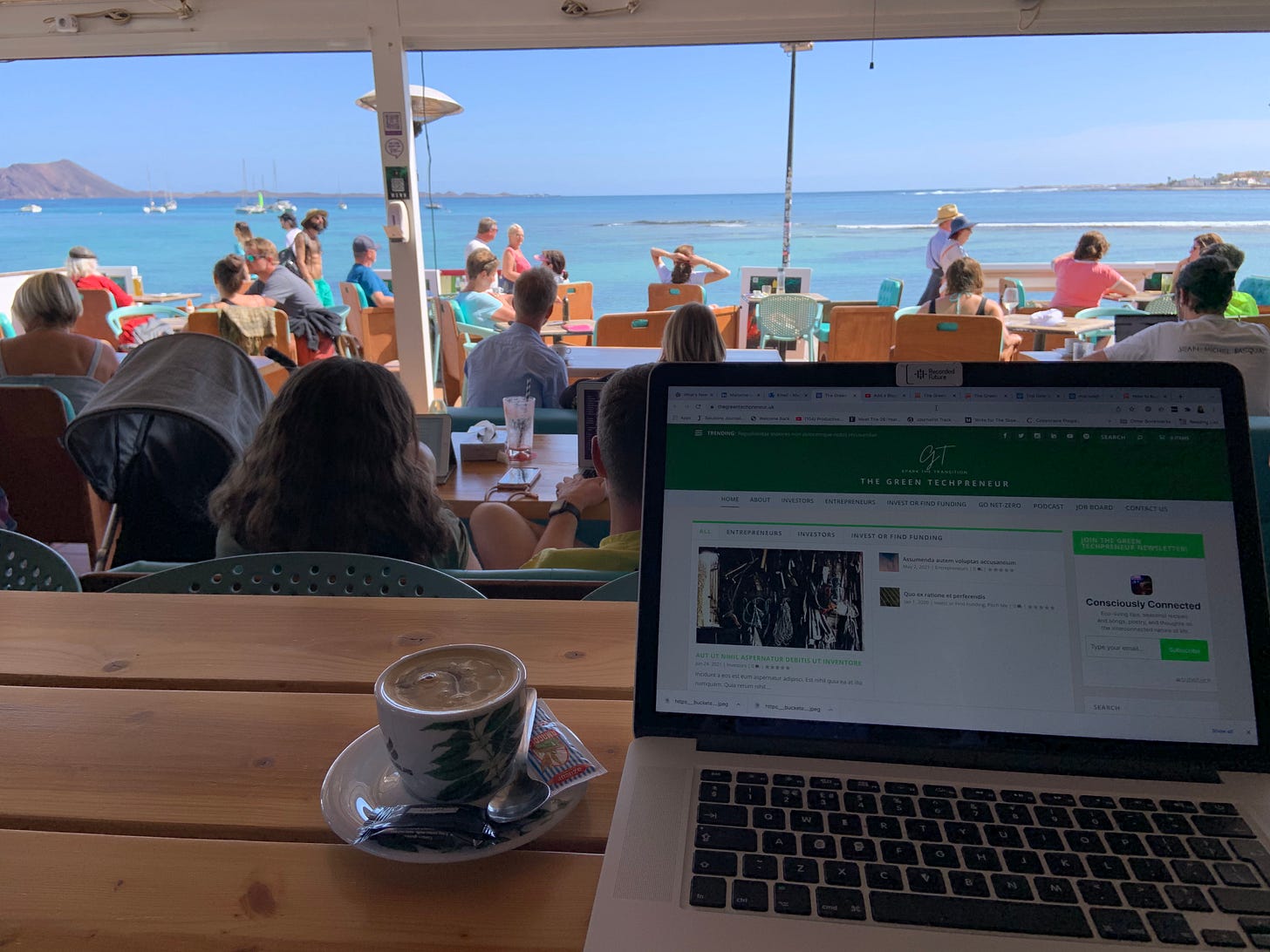I’m looking for 20 Green Techpreneur readers who want to become GT Founding Members:
A Founding Membership costs $500 and benefits include:
LinkedIn for Sustainability Leaders Course
Free advertising on The Green Techpreneur newsletter (1 ad placement)
Exclusive invites to members-only online events
A GT website article (1-dedicated article subject to Terms & Conditions)
Boosted networking in the GT online community
Your name and company listed on the soon-to-come Founding Members’ section of the GT website
….and you’ll have my gratitude and some gifts and surprises! 🙂
Hello Green Techpreneur readers,
After interviewing countless founders and investors and writing about their founder launch journey, I figured it was time to share my story and tell you why I started The Green Techpreneur. I’ll join my interviewees in the vulnerability arena and reveal the behind-the-scenes blood sweat and tears, the hustle and grit that lies in front of, and behind those who choose the entrepreneurial path. Fasten your seatbelts and get ready for a wild ride.
The truth is that in March 2018, when I quit my job as a reinsurance journalist and moved from Brighton to London, I didn’t set out to build an online business or have any dreams of starting The Green Techpreneur. I set out to not be miserable.
I had worked two jobs for one year after finishing my MA in Multimedia Journalism: juggling a part-time, back office job at American Express alongside a 6-month unpaid internship and then a part-time role as a video journalist at Brighton’s local broadcast TV channel – LatestTV. In that chapter of life, two worlds collided.
The corporate world was well-organised and well-managed. I had monthly one-on-one meetings with my manager: a performance review where I was given a chance to discuss any training I wanted to progress in. My work was dull but voluntary overtime was paid 1.5x normal rates, and cake was often passed along the long rows of desks – there was always someone who had a birthday in Amex’s giant, shiny European HQ.
In a chance encounter, I had met someone at a party towards the end of my studies who referred me for an internship at LatestTV. LatestTV was a pub by night and a broadcast studio by day. It smelt of beer, musty furniture and sweat. Equipment was old, heavy, and often missing a piece or breaking down. LatestTV was born because magazine owners in Brighton had gotten a 2-year startup BBC grant to launch a news channel – it was part of a nationwide attempt by BBC, backed by some MPs, to bolster the dying local news sector.
Sadly, the programme was largely unsuccessful, and nearly all fledgling local news start-ups collapsed when the grant money ran out. What it did do, was offer an army of young aspiring journalists a brief window of opportunity to get their foot in the door of a highly competitive, struggling sector.
I would often work a half day at Amex and then run out to LatestTV, pick up a backbreakingly heavy old camera and tripod and whiz off on a news mission, writing the script for the 2-minute news package as I took a bus to the shooting location or interviewee. As a one-woman show, I learnt how to shoot, edit, write for broadcast and self-record my piece-to-camera.
My first paid job with LatestTV was to report on the controversy caused by a photo of Brighton’s naked bike ride. I spoke to local charities, priests, scientists, businesses, residents and politicians. I was paid £60 per day and had to produce two 2-minute news video packages a day. This left me often spending evenings and weekends doing unpaid overtime to catch up on video editing. It was tough, but my heart was in it.
For LatestTV, however, the writing was on the wall. BBC grant money was running out and the company was edging closer to bankruptcy. And after over a year of juggling two jobs, I was running out of energy. I’d gotten my foot in the door of a media career and it was time to move on. But across the UK, media was in trouble. It was incredibly daunting to be running towards an industry that was increasingly fighting for survival.
During my MA, I had done a one-week placement at a local London newsroom and had stayed in touch with one of the reporters. She had been out on the street protesting when her newsroom closed down not long afterwards and she’d begrudgingly gone on to get a job at a tabloid. It was a global phenomenon: in the booming age of social media, tech giants had become the winners and newsrooms the losers. Companies were spending advertising dollars to pay for ads on social media, not newspapers. Many media outlets have since transitioned to putting up paywalls – but less freely available, verified reporting comes at a cost to democracy.
I found that more jobs were going in finance-related journalism than most other news sectors. I got a role in a reinsurance news startup and moved into the world of risk management, cat bonds, insurance-linked securities and…churnalism. There was little to no original reporting. I regurgitated, rehashed and respun press releases, industry reports and articles. I churned and churned and churned – under pressure daily to spin out article after article – produce, produce, produce.
At least I had my weekends free. I tried to write a blog about environmental issues on the weekend. Two years earlier I had gone down the rabbit hole of learning about climate change and I couldn’t unsee what I saw. I had stumbled on an article that shocked me and then I dug in and dove deeper and deeper: oceans close to collapse, soil degradation, soon more plastic than fish in the sea, climate chaos, floods, droughts, freshwater depletion, an existential crisis ahead. I was shocked.
This was before the climate crisis had become front and centre of the news agenda. Why weren’t people talking about how bad things were? Why was most of the world walking around with their head in the sand? Why were people carrying on with life as normal? It was madness.
From that point on I became an activist. I made lifestyle changes to live more sustainably and started encouraging others to do the same. At the Amex office Starbucks cafe, hundreds if not thousands of disposable coffee cups were thrown away daily. I talked about it with my manager; ‘if everyone could keep a mug at their desk and take it down to the cafe, we wouldn’t have to produce so much waste.’ It was easier to create this change at the reinsurance news startup and the boss did buy reusable cups to keep at the office and replace disposables.
As time wore on, my churnalism role ground me down. I regurgitated content at speed day after day, had burn out, and lost all enjoyment I had once had in the creative process. I robotically moved through each day, counting down the hours until work was over and I could go home. In evenings and on weekends I felt exhausted and brain-dead. What had it all been for? Taking out a loan to do an MA in Multimedia Journalism, long evenings spent practising shorthand and studying media law, unpaid internships – to become this low-paid – (I was on 19k a year) – content factory worker? I became increasingly miserable and despondent. I had to break free.
After several months of trying to find a new role in London, I decided to quit my job. I felt I had nothing to lose.
I moved to London with £4,000 in savings and a promise to myself that I would never again live a life of existence. I would do whatever I had to do, but I wanted to truly live each day, not count down the hours until it was over.
I moved into a property guardianship – a scheme where empty buildings waiting to be sold are converted into temporary homes and rented out at a discounted price. I had a room in what had been an office block, and a makeshift shower and kitchen. I was elated. I remember snow falling in a cold winter spell in London and the sheer joy of being in the city with all its diversity and bubbling aliveness. The run-down grungy areas, the elegant parks, the modern skyscrapers and the old pubs.
I had an open highway ahead of me, a clean slate, and it was mine to write on.
I started applying for jobs and had gotten an offer for a role I knew I didn’t really want, but then a friend gave me a ticket to a tech conference that he’d been unable to attend and suggested I use it as a networking opportunity. I had often thought of freelancing as a better alternative to churnalism, but I imagined it would be nearly impossible to achieve – a far-off dream. But what if….what if the self-employment path was possible? I had to try.
Armed with a business suit and business cards that stated the areas I could write about, I made a point of speaking to as many people as I could, passing out my card and asking them if they needed a freelance writer. When I told a conference goer I had quit my job to move to London and become a freelance writer, he said, “it’s a bold move,” I replied that “fortune favours the bold.”
In that conference, someone referred me to a contact who gave me some unpaid work which led to me quickly finding paid freelance work. I had done the thing I thought was impossible, and the red sea had parted before my eyes. I was over the moon with my luck and I became more bold. What if the things we think are difficult are actually easier than we imagine and if we just take the next obvious step in that direction in faith, the next step will become clear?
So I kept on, pushing through fear and uncertainty, stumbling forwards. I quickly learnt that I could get into just about any conference if I requested a media pass. I loved learning about the latest innovation at tech conferences, and I’d look for and approach editors and ask them if they worked with freelancers. I joined and got support from the National Union of Journalists and started sharing my experiences in their panel discussions about freelancing. I joined Google campus’ co-working club and made a friend who was developing a business idea, she suggested I join The Allbright – a private members co-working club for women.
I’d meet these impressive, ambitious women, many of whom had quit the corporate world to pursue a business idea, and felt sheepish introducing myself as a freelance copywriter and journalist. I’d return to my makeshift home in the property guardianship and listen to and be inspired by podcasts about entrepreneurship.
I allowed myself to dream and created a vision board and goals for different areas of my life.
At the Allbright, I was matched with a mentor. I had three business ideas related to the environment, building networks, content and activism, but I was in analysis paralysis, afraid to run with one idea out of fear I’d make the wrong choice. My mentor helped me select an idea. Six months later, when the pandemic hit, my life changed; a window of opportunity emerged and The Green Techpreneur (GT) was born. It led to me getting a Forbes Contributor role to write about climatetech. A year later, another mentor appeared who consistently supported The GT’s growth and encouraged me to grow my support base with board members.
I’ve long since been a fan of motivation and marketing coach Brendon Burchard. Two of his quotes have stuck with me and become my business mantras:
· However small you start, start something that matters.
· When you are willing to learn and believe in your ability to figure things out, then fear becomes tameable.
I’ve bootstrapped The GT – gradually building it as an online resource, podcast and network for climatetech. The course of my life has been shaped by chance encounters and referrals and I believe in the power of creating networks. You never know when one new contact will be transformative for someone’s business or life.
I’ve often rallied against the negative, fear-based bias in the media. Studies have shown it creates anger and frustration that can lead to populism and apathy. Why do we hear so much about murderers, criminals and random accidents, and not enough about all the amazing people and incredible visionaries working on solutions? We need to regain a sense that problems are solvable and that taking action delivers results to combat apathy.
By building The GT I’m creating the change I wish to see in the world. And this is what I love about climatetech innovators – they’re creating the change we need, not just sitting around talking about problems.
I built The GT over 2.5 years while juggling other work. When progress seems slow, I remind myself that I’m building something that matters, and when the way forwards is unclear, I believe in my ability to learn and figure things out. I’m still stumbling forwards.
This year I launched The Green Techpreneur website to transition from the newsletter and podcast into a one-stop shop for climatetech with features to encourage networking and business growth (a jobs board, publishing lists of startups looking for funds, a B2B advertising platform, a Youtube channel).
I’ve focused on plugging my knowledge gaps by taking courses in building an online business, marketing and lead generation. Along the way, I discovered that I’d spread my efforts too thin and I am learning to be more streamlined and strategic and focus on the route to profitability.
The progress I’ve made so far has been down to learning how to effectively use LinkedIn for audience growth and business development: I’ve built a valuable network without spending a penny on ads.
With comparatively little input, LinkedIn makes so much possible.
Here are a couple of stats:
· The GT newsletter on Substack and LinkedIn has nearly 4,000 subscribers
· The GT podcast has had 15,500 downloads
· I have 8,700 LinkedIn followers in the climatetech sector
And although I’ve seen some climatetech leaders excelling at their LinkedIn game, the majority don’t have a consistent messaging strategy or the tools they need to succeed. That’s why I created a course – LinkedIn for Sustainability Leaders – where I’ve combined my own learning curve and observations about what works. If I’d had this knowledge when I first launched The GT, I would have saved many, many hours of time and grown faster.
I’m looking for 20 Green Techpreneur readers who want to become GT Founding Members and purchase the LinkedIn Leadership course for $500.
Founding Member benefits include:
LinkedIn for Sustainability Leaders Course
Free advertising on The Green Techpreneur newsletter (1 ad placement)
Exclusive invites to members-only online events
A GT website article (1-dedicated article subject to Terms & Conditions)
Boosted networking in the GT online community
Your name and company listed on the soon-to-come Founding Members’ section of the GT website
….and you’ll have my gratitude and some gifts and surprises! 🙂
Let’s #SparkTheTransition!
What the course covers:
· Profile Optimisation
· How to stand out as a sustainability leader – worksheet
o Your mission, vision, and unique selling points
o Share two types of news stories
o Use global climate change influencers
Purpose-driven posting
o Relationship-building
o Sales-oriented
How to structure a post
How to boost engagement
How to use video
How to research, select and use hashtags
Use AI tools to consistently grow your network and company followers
Use AI tools for business development
Tackling the algorithm
How to share your story and founder launch journey
o Proven viral messaging tactics















Share this post